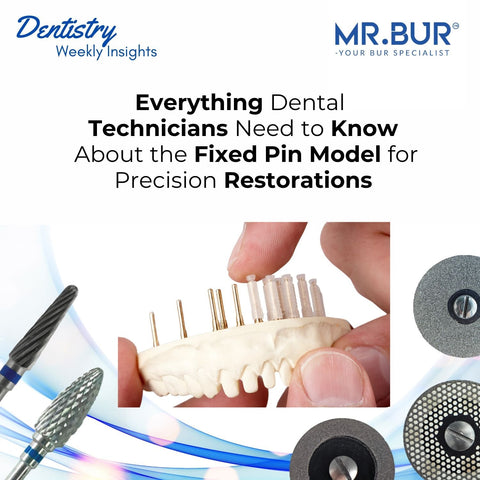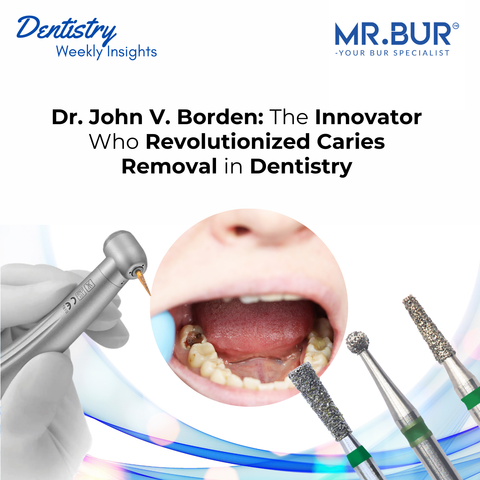In dental labs, precision and durability are everything especially when it comes to trimming dental plaster models. Using the wrong burs can lead to rapid wear, uneven cuts, and excess heat generation, compromising the accuracy of your work. That’s where CVD-coated burs come in.
With CVD (Chemical Vapor Deposition) coating, dental burs become stronger, more wear-resistant, and optimized for smooth plaster trimming. If you're looking for high-performance burs that last longer and maintain superior cutting efficiency, then Mr. Bur CVD Coating Burs Series is your go-to solution.
Why CVD Coating Extends the Life of Dental Burs
1. Superior Hardness & Wear Resistance
-
CVD-coated burs are designed with an ultra-hard protective layer that resists friction and wear, even when trimming abrasive materials like plaster.
-
This means longer service life and fewer replacements, saving time and costs in your dental lab.
2. Enhanced Cutting Efficiency & Precision
-
With a smoother, sharper surface, Mr. Bur CVD-Coated Burs offer faster, cleaner trimming for plaster models.
-
Their low friction design ensures precise detailing without chipping or rough edges.
3. Heat & Corrosion Resistance
-
Repeated sterilization cycles can cause uncoated burs to oxidize and degrade.
-
Mr. Bur’s CVD-coated burs withstand high-temperature autoclaving while maintaining cutting precision and integrity.
Why CVD-Coated Burs Are Ideal for Plaster Trimming
Dental plaster is highly abrasive, causing standard burs to wear down quickly and lose cutting efficiency. Mr. Bur CVD-Coated Burs are designed with a reinforced high-hardness protective layer that significantly enhances resistance to abrasion and friction, ensuring a longer service life and consistent cutting performance. Unlike uncoated burs that degrade rapidly, CVD-coated burs maintain sharpness and efficiency even after extended use, preventing premature wear and reducing the frequency of replacements. Additionally, the smooth surface of the coating minimizes plaster dust accumulation, keeping the bur cleaner and ensuring continuous, precise trimming without clogging. By using Mr. Bur CVD Coating Burs Series, dental professionals can achieve efficient, high-precision plaster trimming with reduced wear and better long-term performance.
PVD Coating vs. CVD Coating
When it comes to enhancing the durability, performance, and longevity of dental burs, two of the most widely used coating techniques are PVD (Physical Vapor Deposition) and CVD (Chemical Vapor Deposition). While both methods improve wear resistance, cutting efficiency, and corrosion protection, they differ in application processes, temperature requirements, coating thickness, and overall performance characteristics.
1. Application Process: PVD vs. CVD
PVD Coating (Physical Vapor Deposition)
-
Uses a vacuum chamber where metal compounds are vaporized and then condensed onto the surface of the bur.
-
The two primary PVD techniques:
-
Arc Ion Plating: Uses high electrical currents to ionize the metal, which is then deposited as a thin film.
-
Sputtering: Uses magnetic fields and reactive gases to direct metal ions onto the bur, resulting in a smoother coating with fewer defects.
-
Temperature range: 150 – 750°C (302 – 1382°F), which is relatively low, preventing thermal distortion of delicate substrates.
-
Deposition speed: Faster with arc ion plating but more controlled with sputtering.
CVD Coating (Chemical Vapor Deposition)
-
Uses chemical reactions in a high-temperature vacuum chamber to bond metal compounds onto the bur.
-
Requires reactive gases (e.g., chlorine) to transport the metal in a gaseous state before it chemically bonds to the substrate.
-
Temperature range: 600 – 1000°C (1112 – 2012°F), which is significantly higher than PVD, making it more suitable for materials that can withstand extreme heat.
-
Deposition speed: Generally slower than PVD but results in a thicker and more durable coating.
Key Difference:
PVD is a lower-temperature process that relies on physical deposition, while CVD is a high-temperature chemical bonding process that creates stronger adhesion.
2. Coating Thickness & Hardness
|
Feature |
PVD Coating |
CVD Coating |
|
Coating Thickness |
1-5 μm (micrometers) |
5-10 μm (micrometers) |
|
Hardness |
Moderate to high |
Very high |
|
Adhesion Strength |
Good |
Excellent |
|
Surface Smoothness |
Very smooth (especially sputtering) |
Slightly rougher due to thicker layers |
|
Residual Stress |
Low (minimal impact on bur material) |
High (requires heat-resistant substrates) |
Key Difference:
-
PVD coatings are thinner, offering a smooth surface ideal for precision work, such as dental restoration finishing and cavity preparation.
-
CVD coatings are thicker, providing exceptional durability, making them ideal for cutting through hard materials like zirconia, metal crowns, and dental plaster.
3. Durability & Wear Resistance
PVD Coating
-
High wear resistance, but slightly lower than CVD due to its thinner layers.
-
Smooth surface reduces friction and heat generation, improving efficiency.
-
Better suited for delicate procedures where surface smoothness is crucial.
CVD Coating
-
Superior wear resistance, thanks to its thicker, denser layers.
-
More resistant to abrasive materials, making it the preferred choice for plaster trimming, zirconia cutting, and metal prosthetic work.
-
Provides longer-lasting performance, but may generate more heat due to its thickness.
Key Difference:
-
PVD is better for precision trimming due to its smoother finish.
-
CVD is more durable and ideal for high-load, high-wear applications, such as plaster trimming and zirconia crown cutting.
4. Heat Resistance & Thermal Conductivity
|
Feature |
PVD Coating |
CVD Coating |
|
Heat Resistance |
Moderate (good for standard autoclaving) |
Very high (suitable for extreme sterilization conditions) |
|
Thermal Conductivity |
Low (absorbs less heat, stays cooler) |
High (absorbs and retains heat, may cause overheating) |
Key Difference:
-
PVD is preferred for heat-sensitive applications since it operates at lower temperatures and prevents excessive heat buildup.
-
CVD is excellent for high-load procedures but may cause higher heat generation, requiring controlled cooling.
5. Cost Considerations: PVD vs. CVD
|
Factor |
PVD Coating |
CVD Coating |
|
Selling Cost |
Moderate |
Slightly higher |
|
Bur Lifespan |
Moderate |
Very long |
|
Replacement Frequency |
Frequent |
Low (longer-lasting) |
|
Overall Cost-Effectiveness |
Moderate |
Best for high-wear applications |

For dental professionals seeking the most durable solution for plaster trimming, Mr. Bur CVD Coating Burs Series is the ideal choice, offering superior resistance to abrasion, heat, and wear.
Diamond Burs, Carbide Burs, Surgical & Lab Use Burs, Endodontic burs, IPR Kit, Crown Cutting Kit, Gingivectomy Kit, Root Planning Kit, Orthodontic Kit, Composite Polishers, High Speed Burs, Low Speed Burs







